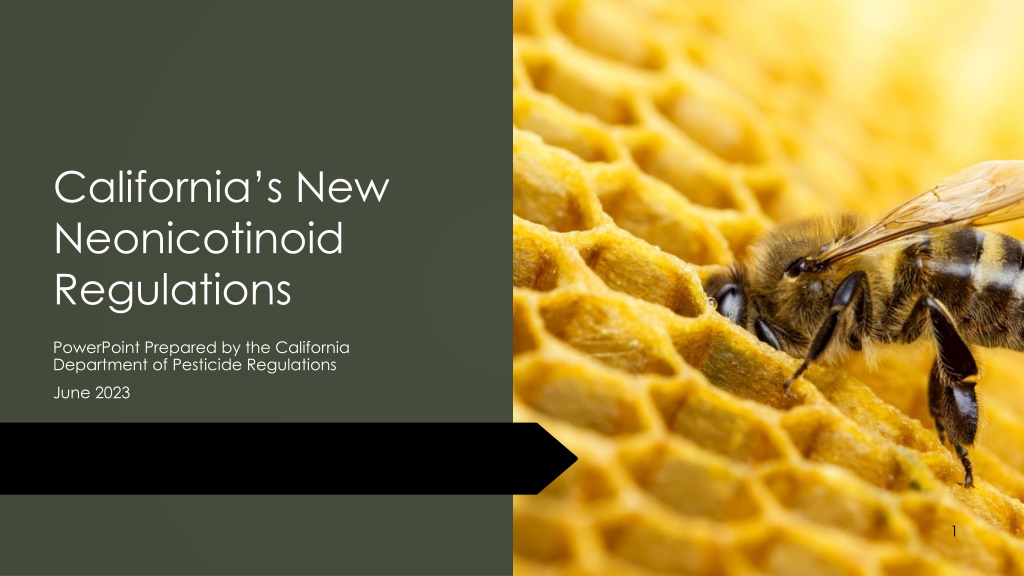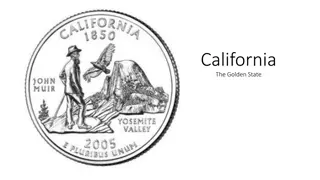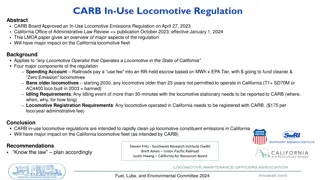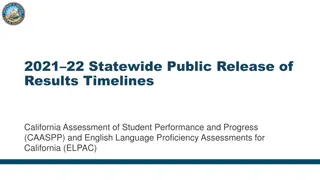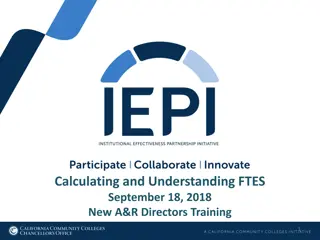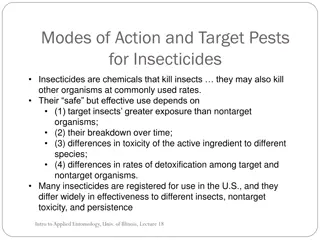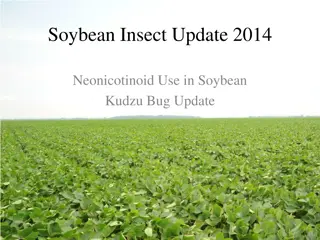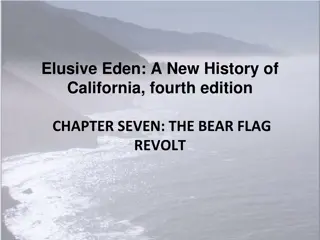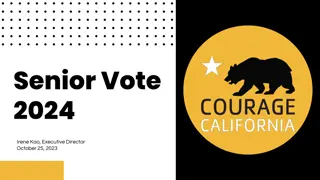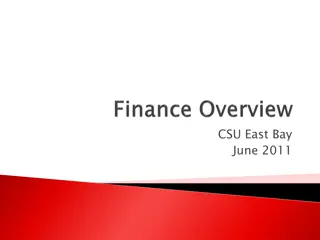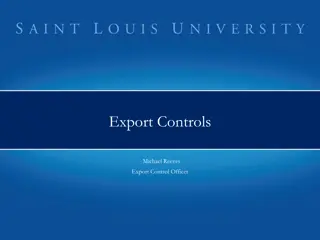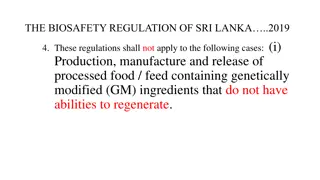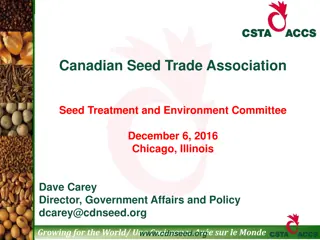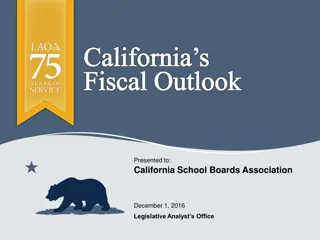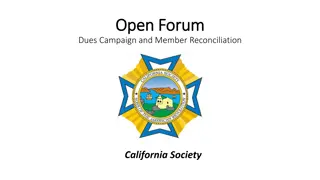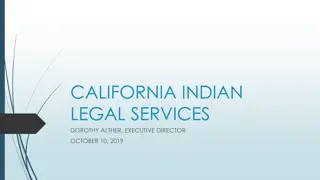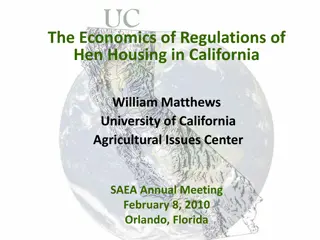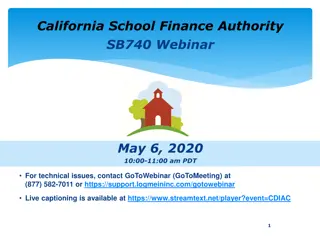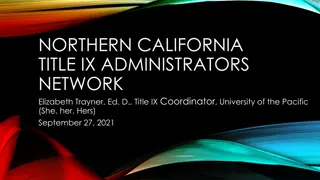New Regulations on Neonicotinoids in California: An Overview
The presentation by the California Department of Pesticide Regulations highlights the new regulations on neonicotinoids, systemic pesticides affecting insects' central nervous systems. It provides insights into the history of neonicotinoid use in California, the development of alternative pesticides, and the potential risks to pollinators. The regulations include definitions, scope, exemptions, classes of crops, and restrictions, emphasizing the timeline and future steps. The timeline traces significant events from 1994 to the latest regulation filing in April 2023, with an effective date of 1/1/24. Key definitions in the regulations encompass bloom periods, growing seasons, and managed pollinators to protect agriculture and pollinator populations.
Download Presentation

Please find below an Image/Link to download the presentation.
The content on the website is provided AS IS for your information and personal use only. It may not be sold, licensed, or shared on other websites without obtaining consent from the author. Download presentation by click this link. If you encounter any issues during the download, it is possible that the publisher has removed the file from their server.
E N D
Presentation Transcript
Californias New Neonicotinoid Regulations PowerPoint Prepared by the California Department of Pesticide Regulations June 2023 1
Overview Neonicotinoids Brief history Summary of the new regulations o Definitions/Scope/Exemptions o Three classes of crops o Restrictions on each class Timeline and next steps 2
Neonicotinoids Developed as alternatives to organophosphates and carbamates Affect insect central nervous system, resulting in paralysis and death Systemic pesticides o Absorbed into plants and translocated throughout plant tissues o Residues can be found in the pollen and nectar consumed by bees and other pollinators Imidacloprid Dinotefuran Clothianidin Thiamethoxam 3
Brief History 1994: Imidacloprid first registered for use in California 2008: DPR received adverse effects disclosure that showed potentially harmful effects of imidacloprid to pollinators 2009: The four neonicotinoids entered DPR reevaluation o Limited to uses to produce agricultural food or feed commodities o Did not include trees grown for lumber and wood products, Christmas trees, ornamentals and cut flowers, and turf grown commercially for sod 4
Brief History (Continued) 2014: Assembly Bill (AB) 1789 adopted FAC section 12838 July 2018: Risk Determination submitted to the Legislature Feb 2022: Regulation noticed for public comment April 2023: Regulation filed with Secretary of State, effective 1/1/24 5
Neonicotinoid Pesticide Exposure Protection Regulation Summary 6
Three Definitions in Section 6990(a) Bloom: the period from the onset of flowering until petal fall is complete o Citrus in Fresno, Kern, or Tulare follow 6984(b) o Grain crops: heading (inflorescence or tassel emergence) to harvest Growing season: period of planting to harvest for annual or biennial crops, not more than one year for perennials Managed pollinators: bees introduced in a field to provide pollination services to the crops in the field 7
Scope 6990(b) limits the regulations to foliar and soil applications of neonicotinoids when used to produce certain agricultural commodities. o Arranged by Crop Groupings found in 40 CFR section 180.41(c) used for pesticide residue tolerances and referenced on many pesticide labels o Regulations do not apply to neonicotinoid use in non-agricultural (e.g., structural or home use) or non-crop (e.g., parks or cemeteries) settings, or to applications to nursery stock This Photo This Photo by Unknown Author is licensed under CC BY-SA-NC almond blossoms CC BY-SA-NC 8
Exemptions Examples of some exempted applications in section 6990(c): 1) In enclosed spaces or insect exclusionary structures/netting 2) To control a quarantine pest 3) Under a FIFRA Section 18 emergency exemption Also, a crop group section may list crops that are exempt from the article (ex: mulberries in Berries and Small Fruit) This Photo This Photo by Unknown Author is licensed under CC BY-SA Netting used to keep out insects CC BY-SA 9
Crop Group Restrictions Sections 6990.1 6990.16 Three broad crop group categories: Crops normally harvested before bloom Crops normally harvested after bloom Certain other crops where DPR was not able to determine the combinations of application rates and timings that are safe or low risk to pollinators o o o 10
Crops Which Are Normally Harvested Before Bloom Crop groups (example crops) Bulb vegetables (e.g., garlic) Herbs and spices (e.g., basil, thyme) Leafy Vegetables including Brassica (e.g., asparagus, celery, broccoli, kale, lettuce, spinach) Certain miscellaneous crops (artichokes) Certain root and tuber vegetables normally harvested before bloom (e.g., carrots, beets, parsnips, radishes) 11
Restrictions on Crops Which Are Normally Harvested Before Bloom a) When the crop is harvested before bloom, the crop is not subject to the article. Follow neonicotinoid product label instructions. b) However, if the crop will bloom (e.g., for seed production), neonicotinoid use is prohibited on the crop. For root and tuber vegetables harvested after bloom or grown for seed, follow next section instead This Photo This Photo by Unknown Author is licensed under CC BY-ND CC BY-ND artichoke blossoms 12
Crops Which Are Normally Harvested After Bloom Crop groups (example crops) Berries and small fruits (e.g., grape, raspberry) Cereal grains* (e.g., corn) Citrus fruits (e.g., lemon, orange) Cucurbit vegetables (e.g., cucumber, pumpkin) Fruiting vegetables (e.g., tomato) Legume vegetables (e.g., bean, pea) Strawberry plant Oilseed crops (e.g., canola, sunflower) Pome fruits (e.g., apple, pear) Other root and tuber vegetables (e.g., potatoes) Stone fruits (e.g., cherry, peach) Tree nuts (e.g., almond, walnut) 13
Restrictions on Crops Which Are Normally Harvested After Bloom a) Use is prohibited during bloom. b) Additional use restrictions if multiple AIs or both soil and foliar application methods are used on the crop during the growing season. c) Additional use restrictions if managed pollinators will be used with the crop during the growing season. d) Additional restrictions for certain crops. Orange tree 14
Other Crops Crop groups (example crops) Tropical and subtropical fruit, edible peel (e.g., date, fig, olive) Tropical and subtropical fruit, inedible peel (e.g., avocado, pomegranate, prickly pear fruit) Certain miscellaneous crops (coffee and peanuts) Reminder: These are the crops where DPR was not able to determine the combinations of application rates and timings that are safe or low risk to pollinators olive tree 15
Restrictions on Other Crops a) Use is prohibited during bloom. b) Only one neonicotinoid AI is permitted per growing season. c) Only one application method (soil or foliar) is permitted per growing season. d) If managed pollinators will be used with the crop, neonicotinoid use is prohibited. avocado blossom 16
Timeline & Next Steps in California 17 Regulation filed with Secretary of State on 4/10/23 Regulation effective 1/1/24 DPR planning outreach activities
A Last Note The neonicotinoid AIs are currently undergoing Registration Review at EPA Feb 2020: Released Proposed Interim Decisions (PIDs) Fall 2023: Anticipate releasing amended PIDs that will include additional mitigation measures to reduce neonicotinoid exposures for non-target organisms, including some listed species 2024: Anticipates releasing Interim Decision and final listed species biological evaluation Any needed label changes to follow Excerpt of 2020 Imidacloprid PID Table of Contents 18
Questions? For more information on the regulations, visit the following links: www.cdpr.ca.gov/neonicotinoiduse/ www.cdpr.ca.gov/neonicotinoid use/ www.cdpr.ca.gov/neonicotinoiduse/ https://www.cdpr.ca.gov/docs/legbills/rulepkgs/22-001/22-001.htm https://www.cdpr.ca.gov/docs/legbills /rulepkgs/22-001/22-001.htm https://www.cdpr.ca.gov/docs/legbills/rulepkgs/22-001/22-001.htm 19
